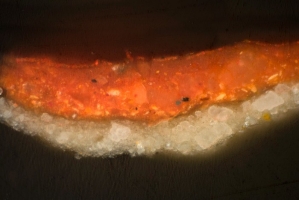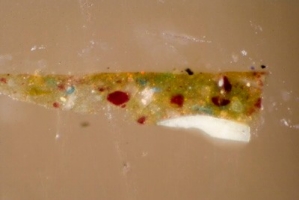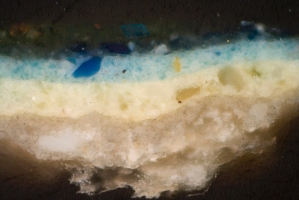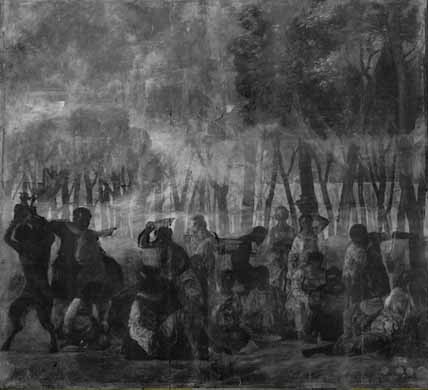Giorgione’s painting is typified by the exquisite brushwork he used to depict both color and texture. The quality and distinction of his painting was achieved through his command of the oil medium and his use of colorants of exceptional quality that could be obtained at color sellers in Venice. His paint was applied in few, thin layers. A cross-section from the Virgin’s mantle shows how he painted a layer of pure, deep red as an underlayer to further warm and enrich the hue of the ultramarine blue of the cloak. The brilliance of the red pigment is enhanced by the addition of a finely ground glass.
16th-Century Renaissance Pigments and Painting Techniques
Venetian colore, or color, is admired for its sheer brilliance and bravado. Artists, calledfigurers, were part of a larger industry of color that thrived in Venice. Dyers, glassmakers, tailors, and decorators of furniture and ceramics all employed bright colors. Within the industry of color, shopkeepers--vendecolori--emerged as specialists. Today we would call them colormen: their profession evolved first in Venice, where they were trading by the end of the 15th century. They offered a panoply of materials for the color industry, including raw materials for colorant and dye manufacture, glassmaking, and prepared pigments. They dabbled in international trade and offered many imported colors in addition to ones prepared locally. Their inventories list azurite, orpiment, and vermilion, among many other items.
The range of materials at the vendecolori was notable for its breadth. The vendecolori sold materials of the highest quality and appear to have been in the position of offering highly refined and purified colorants. At the vendecolori, artists could acquire materials of all sorts; some were intended for other trades, but could be used by oil painters. Among these were the glassy pigments made for the majolica and glassware decorators, and the pigments used by manuscript illuminators. The ready availability of these at the vendecolori increased the gamut of colors available to artists and the range of properties of new materials facilitated experimentation with coloristic effects.
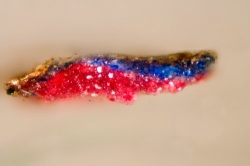
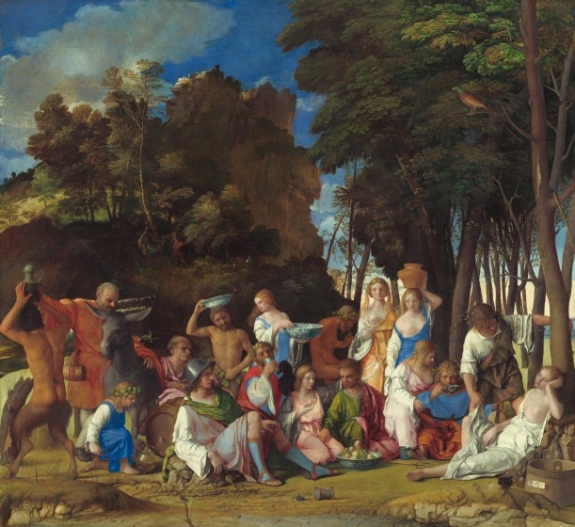
Giovanni Bellini and Titian, The Feast of the Gods, 1514/1529, oil on canvas, National Gallery of Art, Widener Collection, 1942.9.1
Giovanni Bellini was an innovative painter throughout the length of his career. He adopted materials and colors that not only enriched but also defined the Venetian palette, such as indigo, the pair of pigments orpiment and realgar, and lavish use of the deep green, copper resinate. In Feast of the Gods, Bellini painted Silenus’ orange robe with orpiment mixed with a transparent red lake pigment.
Bellini mixed a little orange glassy material of the sort used by ceramic decorators into azurite to achieve the perfect hue for suggesting hills at the horizon in the far distance.
A consummate colorist, Bellini added transparent red pigment into green copper resinate glaze to mute the strident intensity of its tone and to strike just the right color for Priapus’ tunic.
The x-radiograph of the painting shows that Bellini painted the trees and added the landscape around them. The infrared radiograph suggests the trunks and some of the branches were outlined in dark paint. The gods and nymphs were not outlined this way, yet the complexity of the composition seems to demand that there was some underdrawing. The sweep of a brush loaded with oil paint pulls up charcoal drawings, so perhaps Bellini, anticipating later writers’ description of how to paint, dusted off his drawing as he painted. One sample shows a trace of underdrawing, just a few specks of black, lying on a thin white lead priming which is over the gesso on the canvas.
For more information on The Feast of the Gods: David Bull and Joyce Plesters,"The Feast of the Gods: Conservation, Examination, and Interpretation." Vol. 40, Studies in the History of Art Monograph Series II. Washington: National Gallery of Art, 1990.
For more information on the vendecolori: Barbara H. Berrie and Louisa C. Matthew, "Venetian Colore: Artists at the Intersection of Technology and History," in Bellini, Giorgione, Titian, and the Renaissance of Venetian Painting, edited by D. A. Brown and S. Ferino-Pagden, Washington and Vienna: National Gallery of Art and Kunsthistorisches Museum, 2006.
Barbara H. Berrie and Louisa C. Matthew, "Material Innovation and Artistic Invention: New Materials and New Colors in Renaissance Venetian Paintings," in Scientific Examination of Art: Modern Techniques in Conservation and Analysis. Washington: National Academy Press, 2005.
Louisa C. Matthew and Barbara H. Berrie, "'Memoria de colori che bisognino torre a vinetia': Venice as a Centre for the Purchase of Painters' Colours," in Trade in Artists' Materials: Markets and Commerce in Europe to 1700, edited by J. Kirby, S. Nash and J. Cannon. London: Archetype, 2010.
Conservation Division
National Gallery of Art
2000B South Club Drive
Landover, MD 20785
[email protected]
